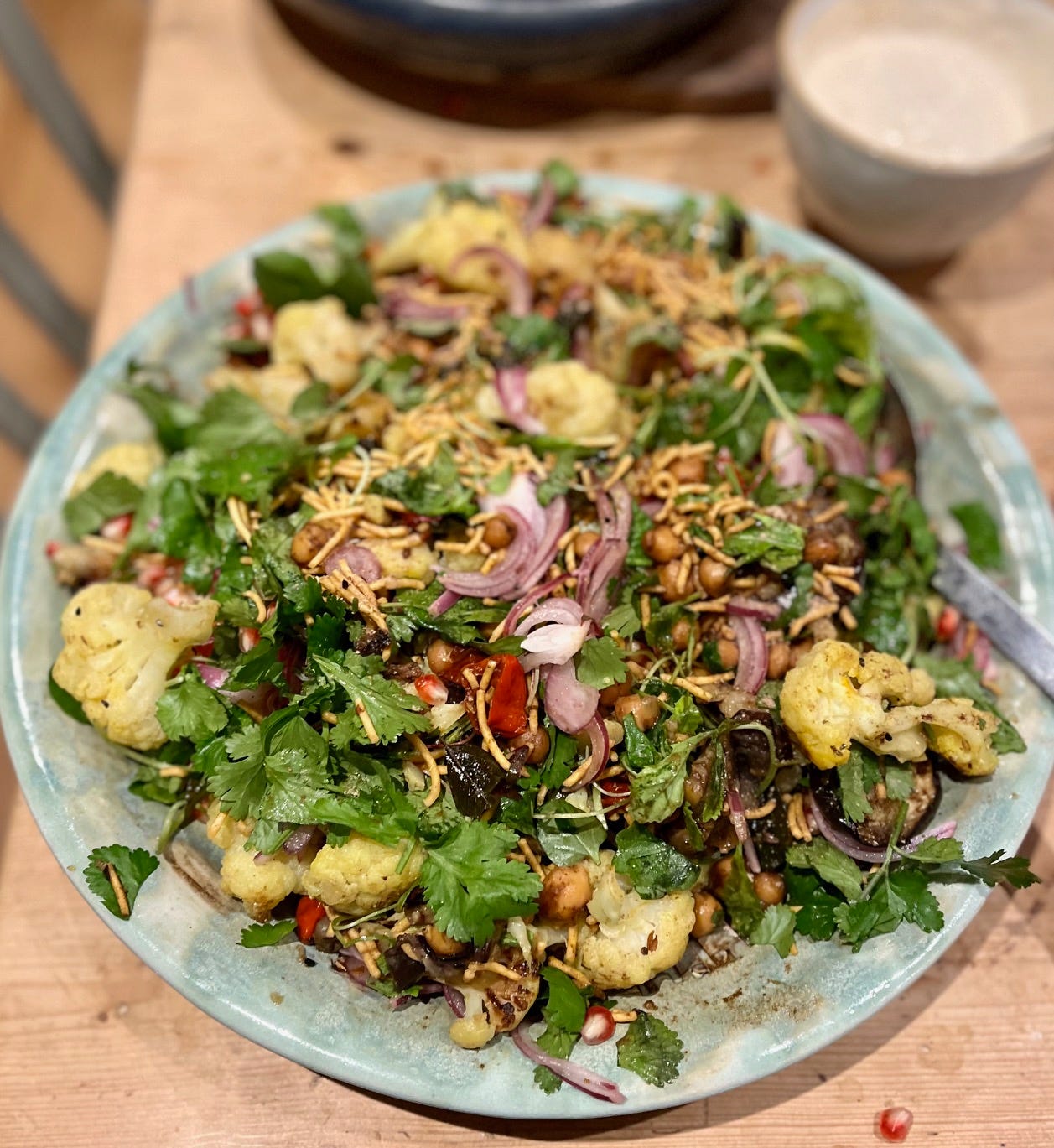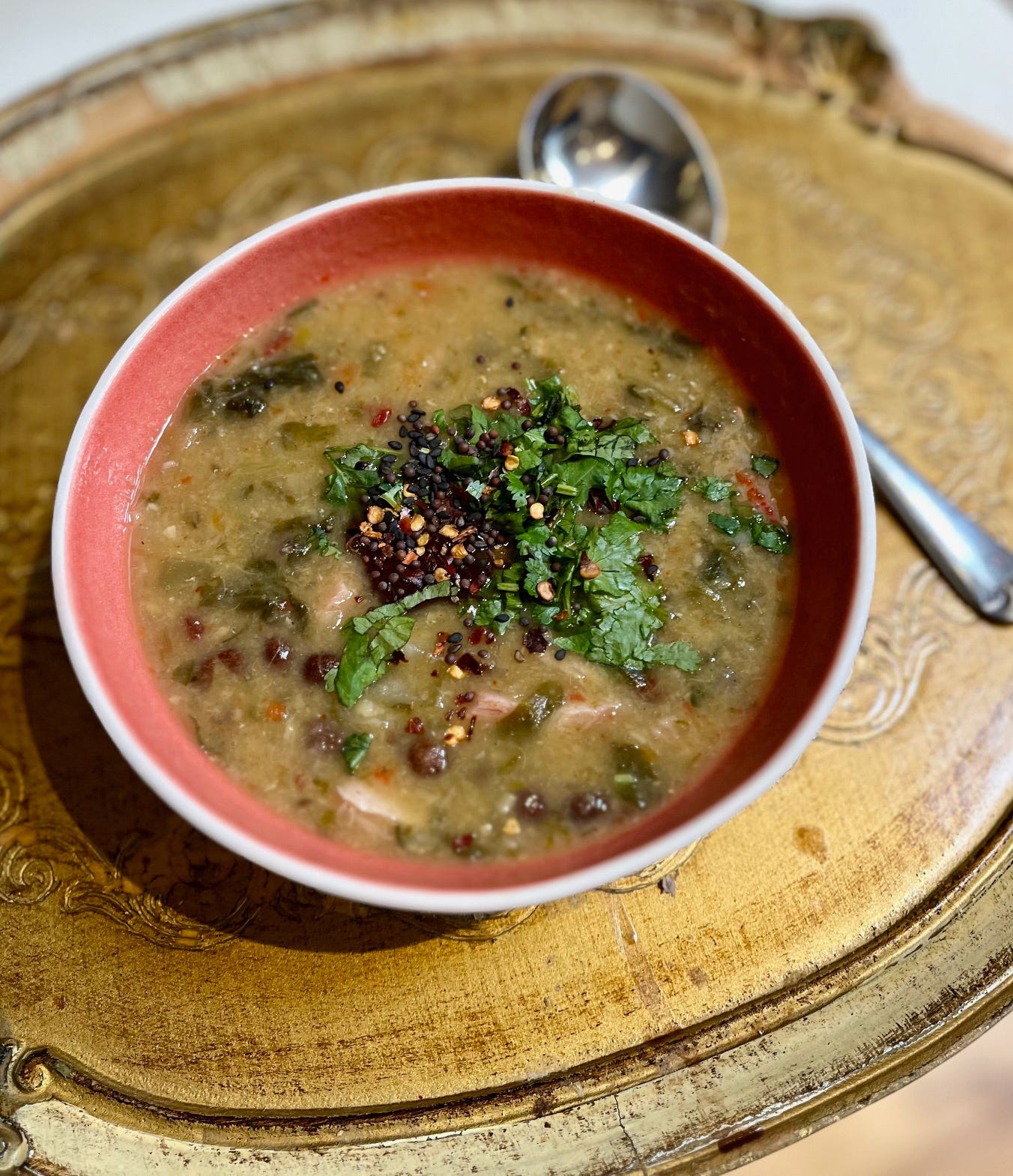We are just two weeks away from the publication of Everyday Pressure Cooking and as there are now copies out in the wild, being snapped up by people attending demos (thank you all!), I thought another little preview might be in order. Here is a flick through - if it at all whets your appetite, please do consider pre ordering. Thank you!
I’ve been demoing a lot recently and one of the dishes which has captured everyone’s imagination is my version of a chaat. A version of this recipe appears in Everyday Pressure Cooking in the weekend chapter as it is the sort of thing that works really well as a starter/part of a larger spread but it also works really well as a light meal. If you have all the ingredients to hand - including in this case, cooked chickpeas (batch cooking is your friend!), it is ridiculously fast. The cooked elements take just a few minutes apiece - it is why I like demoing as the curry and the roast cauliflowers show off pressure cooking so well - then it is really just an elaborate assembly job.
My chaat is quite inauthentic, or at least is as inauthentic as something like chaat can be as it is such a moveable feast. But as my household is part South Asian, so I feel justified in presenting it as a family version that we all love. This variant has sev - a skinnier version of the deep fried noodles you find in Bombay mix - they’re made out of all kinds of starch and I find the sort most easily found are made out of gram flour. You can also add puris or samosas (crisped and chopped up) or perhaps fried potatoes.
For me, chaats are about sour flavours. So I put tamarind in the curry element, I dress the onions with lime juice (this is the deeply inauthentic bit), I add pomegranates and amchoor (ground dried mango). It makes it - if this doesn’t sound oxymoronic - both satisfying and moreish. It is important to get the balance right. Too much greenery leads to “this is supposed to be a chaat, not a salad” comments which immediately make me add another large handful of sev. Having said that, I am always looking for opportunities to increase the number of plants in my dishes - only where they work - and the leaves do work here. Even just using one leaf plus coriander, if you count up all the other plants in the dish - including the spices in the garam masala/curry powder, you easily exceed 30. That’s in one meal, let alone in the recommended week.
For the chickpeas:
1 tbsp coconut oil
2 red peppers, cut into strips
2 garlic cloves, finely chopped
10g ginger, finely chopped
500g cooked chickpeas
1 tbsp tamarind paste (I used the concentrated stuff, use more if yours isn’t)
1 tsp garam masala or curry powder
For the cauliflower:
1 tbsp coconut oil
A few curry leaves (optional)
1/2 tsp each nigella, mustard and cumin seeds
1 medium cauliflower, cut into small florets, leaves included
1 tsp curry powder
To assemble:
100g baby spinach leaves , salad leaves, or microleaves
Seeds of a small pomegranate
1 red onion, finely sliced
Juice of 1 lime or ½ lemon
250g yogurt
2 tbsp mango chutney or similar
100-125g thin sev or similar (Bombay mix will work at a pinch)
1 tsp amchoor (optional)
A small bunch coriander
2-3 green chillies, finely sliced
First get your prep done – the cooking is very fast with this recipe, so it is best to make sure that you have everything ready to go. Sprinkle the red onion with half a teaspoon of salt, pour over the lime or lemon juice, toss gently and leave to marinade. Mix together the yogurt and chutney and season with salt and pepper.
Next cook the chickpeas. Heat your pressure cooker and add the coconut oil. When it has melted, add the peppers, garlic and ginger and saute for a couple of minutes. Add the chickpeas, tarmarind paste and garam masala and add 150ml water. Season. Give a quick stir, then close the lid, bring up to high pressure and immediately remove from the heat. Leave to drop pressure naturally. Transfer to a bowl to start cooling.
Wash out your pressure cooker and heat it up again. When it is hot, add the coconut oil. When the coconut oil has melted, add the curry leaves and seeds. When they have started to crackle and pop, add the cauliflower and saute on a high heat for 2 minutes until it takes on some colour. Stir in the curry powder and add 75ml water. This will create a lot of steam – click the lid into place as soon as you can and bring up to high pressure. Remove from the heat immediately and leave to drop pressure for 30 seconds before releasing the rest of the pressure.
To assemble, take a large platter. Arrange the chickpeas, peppers and onions over it with just a little of the cooking liquor, then stir in the leaves. Sprinkle over some of the sev, then top with the cauliflower. Give everything a couple of stirs, then sprinkle over more sev. Drizzle over a couple of spoonfuls of the chickpea cooking liquor. Drain the shallots and sprinkle those over with the pomegranate seeds, chillies and plenty of coriander. Top with more sev and sprinkle amchoor over the lot. Serve the spiced yogurt on the side.
And before I go, a couple more lunches….
Now, as I mentioned in my last post, I am thinking a bit more about nutrition at the moment. Not that I don’t always, but I am making more of an effort to write about it. So the chaat above is a great one to get lots of variety into (I sometimes also make the curry with extra vegetables - grilled aubergines, sweet potato or use leftover vegetable curry as a base), but here are a couple of ways I’ve adapted other dishes in the past week.
A couple of days last week, I made pasta for Adam’s lunch and made enough for me too. So when it came for me to reheat it, it was already better nutritionally because by that point the pasta had become resistant starch - this means that it won’t be digested in the small intestine, but becomes an excellent source of food for all the gut bacteria in your large intestine. It in effect behaves like soluble fibre - it becomes prebiotic and also better for anyone who struggles with blood sugar spikes.
So for making a big batch of pasta makes sense in terms of fuel consumption, but also in terms of health, if you eat it cold or reheated. I reheat mine in the pressure cooker and add extra vegetables at the same time. This one was made with a little bacon, onion and garlic. When I reheated it (with just a splash of water in the base of the cooker), I added some cooked carlin peas, as well as raw courgette and broccoli. These cooked in zero minutes, fast release, and of course the pasta was piping hot in that time. Then I added micro leaves and cheese.
Another recipe in Everyday Pressure Cooking is an all in one method of cooking a piece of ham or gammon with split peas or lentils for soup. I’ve replicated that particular recipe here - it’s an excellent one for this time of year - and this was yet another variation. I took leftovers and added many more vegetables (finely diced sweet potato, celery, carrot, red pepper, tomatoes) greens (chard) and more carlin peas. Again, this was cooked at zero minutes and this time I let it drop pressure naturally. I added more herbs and a sprinkling of seeds (sesame, mustard, nigella) and stirred in dollops of mango chutney.
If you have got this far, thank you for reading! It is a free post, so please do share with anyone you think might enjoy it. And thank you to everyone who has subscribed, recently or otherwise. You will notice that most of the posts are free to read, and any about how to pressure cook - anything that covers methodology - will remain open access forever. Having said that, if you are able to upgrade to a paid subscription, please consider it. It does allow me to spend more time on these newsletters. Thank you again!








Brilliant. I want to make a gigantic chaat for Boxing Day now. But ideally I’d like to find a good South Asian supermarket to buy things like sev, tamarind and assorted pulses. I know you’re in West London like me, Catherine- do you know a good one?
Catherine, I love how easy this all looks. I’ve a pressure cooker fan for many years. However we are mostly vegetarian with a little fish - this looks quite “meaty” from the flick through. Any change of a veggie version?